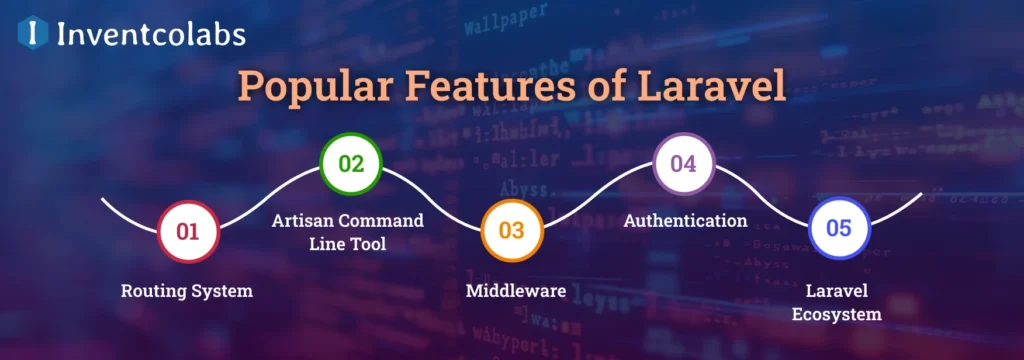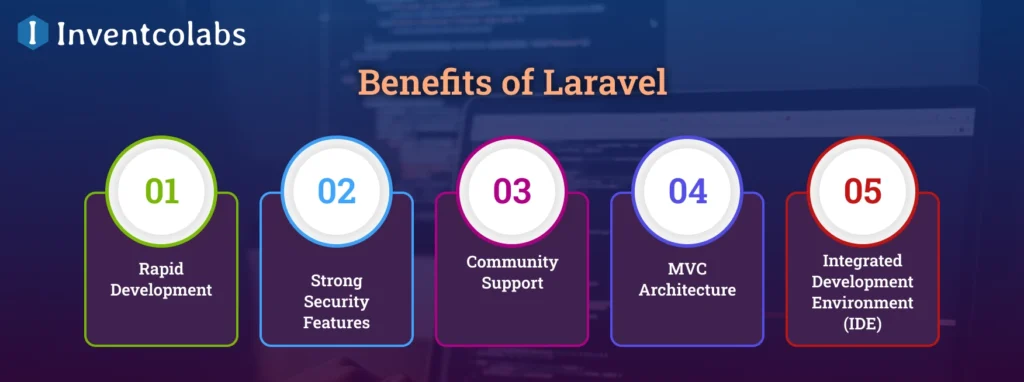In the world of web development, choosing the right framework or library can significantly impact your project’s success. Among the top contenders in the modern development space are Laravel and ReactJS. Laravel is an experimental web application development framework based on PHP whereas ReactJS is JavaScript for a similar UI.
When deciding between Laravel vs ReactJS, it’s important to understand their capabilities, advantages, and best use cases. In this article, we will explore the difference between Laravel and ReactJS, their popular features, benefits, and drawbacks, and make a detailed comparison to help you make the right decision for your project.
Whether you are interested in web development, mobile application development, or full-stack development, knowing which tool to choose is essential. Let’s dive in.
What is Laravel?
Laravel is a PHP framework whose main purpose is to create web applications. It is done in a manner that is simple, elegant, and, most importantly, easy for the developer. Laravel uses the MVC model, which breaks down the project into the model, view and controller layers. It offers various built-in features such as authentication, routing, sessions, caching, and more, making it an ideal choice for web developers who want to create scalable, secure, and maintainable applications.
Features of Laravel:

- Routing System: Laravel’s routing system is one of the strongest and it facilitates easy management of your application URL routes.
- Eloquent ORM: This is Laravel’s own ORM through which we can handle database operations without using complicated SQL statements.
- Blade Templating Engine: This framework offers designers a very basic but sound templating engine known as Blade, which makes it easy to separate the look and feel from the functionality.
- Artisan CLI: Laravel has a command-line interface that will evaluate tasks that take more time and make the work easier for the developer.
- Security: Laravel contains some security measures including, Cross Site Request Forgery (CSRF) protection, Password Hashing and SQL Injection protection.
Explore More: Flutter Vs React Native – Detailed Framework Comparison
What is ReactJS?
Generally, it is called React or ReactJS and is a JavaScript library for building UI developed by Facebook. React is used to develop applications using reusable components with a lot of emphasis on the ways of managing as well as maintaining the existing components. Unlike Laravel, which is a backend framework, React is primarily used for front-end development. It enables developers to build dynamic and interactive web applications, making it the go-to choice for creating single-page applications (SPAs) and mobile apps.
Features of ReactJS:

- Component-Based Architecture: React is picking apart the UI into elements that are easier to use once again and to manage larger applications.
- Virtual DOM: React uses a concept similar to DOM but it is called virtual DOM to enhance the performance because only the changed components are rendered.
- One-Way Data Binding: React uses a one-way data flow and guarantees that information is transmitted only from the parent component to the child component.
- JSX (JavaScript XML): JSX is an extension of JavaScript which looks like HTML to write React components more easily and understand by Developers.
- React Router: A library used in transitioning between various pages in a React application.
Read More: ASP.Net Vs Laravel: Choose the Right One for Web App Development
How Do Laravel and React Work?
Laravel and React in Web Development:
- Laravel is the chosen backend framework of the project. It deals with the business processing, database operations and routing etc. It can manage RESTful API, which can be called by React to dynamically get data.
- React is used to build the front end of the app because it is responsible for rendering UI along with managing its logic for handling user interactions. That interacts with the backend which is Laravel through APIs (it most often uses Axios or Fetch).
When React and Laravel work together, they create a powerful full-stack application, where Laravel handles the backend and React manages the frontend. This combination is known as React with Laravel or Laravel and React.
Popular Features of Laravel

Laravel comes with a large number of inbuilt services that make development of web applications easy. Some of the most popular features include:
- Routing System: Laravel has a very rich routing system and you may use it to define clear restful routes for your application.
- Artisan Command Line Tool: It saves on time since it acts as an assistant to do first what could take ages to develop, otherwise.
- Middleware: Laravel enables the user to add middleware to filter HTTP request in to the application which can be really useful in issues such as authorization and logging.
- Authentication: Laravel comes with easy to implement user authentication, for features such as login, registration and password reset.
- Laravel Ecosystem: Laravel had numerous official tools including Laravel Forge (a tool for hosting), Laravel Envoyer (for deployment), and Lumen (a micro framework).
Popular Features of ReactJS

You can find ReactJS to be used frequently when it comes to the development of user interfaces that are interactive. Here are some of its key features:
- Reusable Components: Much like HTML components, React components are designed to be part of an assembly line that reduces and cuts code.
- Virtual DOM: React’s Virtual DOM optimizes the set of updates required to effect the context swap program on the webpage.
- Unidirectional Data Flow: Data transit is unidirectional and this makes the change in state easier to forecast and if there is a problem, it will be easy to trace the source of the problem.
- React Developer Tools: React provides comprehensive tools of developer for proper debugging and optimization of the React application.
- Hooks: React Hooks make it possible to have the state and the effects of side in a functional component without having to deal with a messy code.
Explore More: MERN Stack vs MEAN Stack: Choose the Right Stack in 2024
Benefits of Laravel vs React
Benefits of Laravel:

- Rapid Development: These aspects enable the development of applications within Laravel because many necessary features are already included within the framework.
- Strong Security Features: Laravel has features such as security features; encryption, CSRF protection, and SQL injections protection.
- Community Support: Laravel is a well-developed framework that has a lot of documentation, tutorials and third party packages available at the present.
- MVC Architecture: MVC pattern makes Laravel easily to handle and maintain as the application develops.
- Integrated Development Environment (IDE): One is that Laravel easily interoperates with most popular IDE for example the php storm to enhance development.
Benefits of ReactJS:

- Faster Performance: React’s Virtual DOM feature keeps the application optimized because only changed components are updated.
- Rich Ecosystem: One more great advantage of React is that it has thousands of third-party tools in itsPossibly library which allows it to interact with other frameworks and technologies.
- Flexibility: React allows for easy extension with other libraries and tools, meaning that the developers get to choose the best tools needed for a given application.
- Popular Among Developers: Being quite popular, you will have a lot of resources, tutorials, and communities that you may turn to for help with development.
- Mobile App Development: It also introduces a new flavour of React, called React Native, for mobile application development across both platforms.
Drawbacks of Laravel vs React
Drawbacks of Laravel:
- PHP Dependency: Laravel comes with PHP and this maybe a let off to developers who are mostly used to other languages such as JavaScript.
- Learning Curve: Laravel has a clean syntax making it easy to understand and work with, however, because of the extensive features, it can be quite complex especially for first time developers.
- Performance: Laravel is generally very good for most applications but IT may not be the best for applications that require large scalability or high-performance applications.
Drawbacks of ReactJS:
- Steep Learning Curve: While React makes the development of any UI comparatively effortless, it has some more complex features like hooks, state management, and JSX which make developing with React difficult for a beginner.
- Tooling and Setup: It can be quite cumbersome for new developers in the React ecosystem to set up a React project with the right tools and configurations.
- SEO Issues: While React is a client-side library it does have some issues with SEO, but it can be solved by using server-side rendering or such frameworks as Next.js.
Laravel vs React: Detailed Comparison to Make the Right Decision
When comparing Laravel vs ReactJS, it’s important to note that they serve different roles in the development stack. Laravel is a backend framework while ReactJS development is a frontend library. So, it should not really matter to you which option you choose, since it should be based on the needs of your project.
- For Backend Development: Laravel is the clear choice. It provides extensive back end features including database and authentication and routing allowing it suitable for development of complex, database-oriented applications.
- For Frontend Development: React is the go-to tool. If you are creating a complex interface that interacts with the user and uses responsive states, you should use React.
- Full-Stack Development: For full-stack development, combining React with Laravel is a common approach. Laravel handles the backend, while React handles the frontend, ensuring scalability, speed, and flexibility.
Which Is Best for Web Development – Laravel Vs React?
If your project is focused on web development, Laravel is the ideal choice for the backend, while ReactJS should be used for the frontend. Combining the two, it is possible to utilize the opportunities of each one and avoid the shortcomings inherent in the work with each instrument. For fast-rendering projects, interactive interfaces and dynamic web applications, React’s components will enhance the best user experience. If you need powerful server-side logic, security, and database management, Laravel will serve as the backbone of your application.
To Conclude
The choice between Laravel vs React depends on your project needs. If you’re working on web development and need a powerful backend, Laravel is the perfect fit. On the other hand, if you require an interactive UI, ReactJS is the best choice. For full stack development, combining Laravel with ReactJS offers a powerful solution for building scalable and maintainable applications. By understanding the difference between Laravel and ReactJS, you can make an informed decision on which technology to use for your next project.
FAQs
Q1. Can I use React with Laravel?
ANS. Yes, you can use React with Laravel to build powerful full-stack applications. Laravel can handle the backend, while React can handle the frontend.
Q2. Which is better, Laravel or React?
ANS. It depends on the requirements of your project. For backend development, Laravel is the best choice, while React is ideal for frontend development.
Q3. Can I use React JS with Laravel for mobile app development?
ANS. Yes, React Native, a library based on ReactJS, can be used to build cross-platform mobile apps alongside Laravel for backend services.
Q4. How do I install React in a Laravel project?
ANS. You can install React in a Laravel project using npm or Yarn. Follow the official Laravel React tutorial for detailed steps.
Q5. Is Laravel React inertia a good choice for building SPAs?
ANS. Yes, Laravel React inertia is an excellent choice for building single-page applications (SPAs), as it allows you to use modern JavaScript libraries like React with the backend provided by Laravel.




